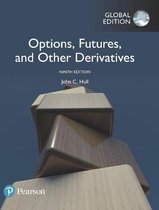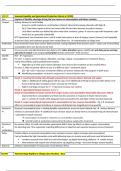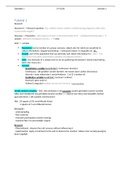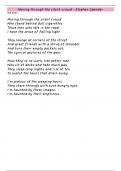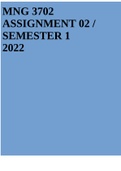Derivative Instruments book
Chapter 1
Derivative is financial instrument whose value depends on the values of underlying variables (prices of traded
assets).
Derivatives exchange is a market where individuals trade standardized contracts that have been defined by the
exchange. Over-the-counter (OTC) market is an important alternative to exchanges and has become much
larger than the exchange-traded market. It is a telephone- and computer-linked network of dealers: trades are
done over the phone and are between financial institutions or between a financial institution and clients.
Advantage: terms of OTC contract do not have to be those specified by an exchange.
Disadvantage: credit risk, that the contract will not be honored.
Forward contract (FC) is an agreement to buy / sell an asset at a certain time for a certain price, traded on the
OTC market. Private agreement. It can be contrasted with a spot contract, which is an agreement to buy / sell an
asset today. FC involves two parties:
1 Long position: agrees to buy the asset on a certain specified future date for a certain specified price.
2 Short position: agrees to sell the asset on the same date for the same price.
FC can be used to hedge foreign currency risk.
Example: corporation will pay £1 million in 6 months and wants to hedge against exchange rate moves.
Treasurer can buy £1 million 6 months forward at an exchange rate of 1.4422 (= offer price of bank):
corporation has a long forward contract on GBP: buys £1 million from the bank for $1.4422 million.
The bank has a short forward contract on GBP: sells £1 million for $1.4422 million.
If the spot exchange rate rose to 1.5000, at the end of the 6 months: FC value $57,800 (= $1,500,000 -
$1,442,200) for the corporation.
K = delivery price (1.4422);
S = spot price at maturity of the
T
contract (1.50000).
Payoff long position in FC on one unit of an asset = ST −K
“Holder of the contract is obligated to buy an asset worth ST for K”.
Payoff short position in FC on one unit of an asset = K−S T
Futures contract is an agreement to buy / sell an asset at a certain time for a certain price, traded on an
exchange market. Standardized agreement. If more traders want to go long than to go short, the price goes up.
Options are traded on exchanges and in OTC market. Two types of option:
1 Call option: right to buy the asset by a certain date for a certain price.
2 Put option: right to sell the asset by a certain date for a certain price.
The price in the contract is the exercise price / strike price; the date is the expiration date / maturity.
American options can be exercised at any time up to the expiration date.
European options can be exercised only on the expiration date.
Differences forward/futures and option:
Options: you have the right to buy/sell, forward/futures: you are obliged to buy/sell.
Options have costs, forward/futures are free.
1
,↑ strike price = ↓ call option ; ↑ put option
↑ time to maturity = ↑ call option ; ↑ put option
Call option:
S0 > strike price: exercise option. Buy 100*strike price, sell immediately for 100*bid price.
S0< strike price: do not exercise option.
Put option:
S0 > strike price: do not exercise option.
S0 < strike price: exercise option. Sell 100*strike price,
Categories of traders:
1. Hedgers use derivatives to reduce risk that they face from potential future movements in a market variable.
2. Speculators use derivatives to bet on the future direction of a market variable.
3. Arbitrageurs take offsetting positions in two or more instruments to lock in a profit.
Hedging
Use derivatives to reduce or eliminate this risk.
When an amount of money is received in the future:
Expected future exchange rate > current exchange rate (bid price forward): do not hedge.
Expected future exchange rate < current exchange rate (bid price forward): hedge.
Microsoft buys put option with strike price
$27.50.
Difference between use of forward contracts / options for hedging:
Forward contracts: neutralize risk by fixing the price that the hedger will pay / receive for the asset.
Option contracts: provide insurance. Protect against adverse price movements in the future while still
allowing them to benefit from favorable price movements.
Speculating
Use derivatives to get extra leverage.
Speculating using futures:
Future contract profit = (future exchange rate – futures price)*dollar amount
Spot contract profit = (future exchange rate – spot price)*dollar amount
calculations do not reflect the interest that is earned / paid.
2
,Speculating using options:
Buy shares profit = (future S0– current S0)*100
Call option profit = (future S0– strike price)*100
call options expire without being exercised, the loss equals the original amount paid for the options.
Difference between use of futures / options for speculating:
Futures: both, potential loss and potential gain, are very large.
Options: loss is limited to the amount paid for the options.
Arbitrage
Use derivatives to take offsetting positions in two markets and lock in a profit.
Buy shares profit = (exchange rate* S0£ - S0$)*100
Transactions costs could eliminate profit for a small investor not for large investment bank.
Arbitrage opportunities do never last long: $ price will rise, £ will fall.
Danger
Investor that want to hedge risk become speculators. So, set up controls and risk limits to ensure that derivatives
are being used for their intended purpose.
Chapter 2 Mechanics of futures markets
Futures contracts do not always lead to delivery: choose to close out positions prior to the delivery period
specified in contract. Closing out a position = entering into the opposite trade to the original one.
Short position: close out position by buying (go long) same contract before delivery date.
Long position: close out position by selling (go short) same contract before delivery date.
Δ futures price = difference opening contract / closing out date.
Futures contract specifies asset, contract size, where/when delivery will be made.
As the delivery period for a futures contract is approached: futures price converges to spot price of the
underlying asset. Delivery period is reached: futures price = spot price:
Delivery period: future price > spot price:
1 sell futures contract, 2 buy asset, 3 make delivery. Profit = future price – spot price.
Delivery period: future price < spot price:
Companies interested in asset will choose long futures contract: ↑ future price.
Operation of margins
Margins to avoid contract defaults.
The broker requires investor to deposit funds in a margin account. The amount that must be deposited at the
time the contract is entered into is known as the initial margin (= an amount per contract). At the end of each
trading day, the margin account is adjusted to reflect the investor’s gain or loss = daily settlement or marking
to market.
(new price – contract price)*contract size = Δ balance margin account
New balance margin account = initial margin + Δ balance margin account
↑ future price = brokers for parties with short positions pay money to exchange and brokers for parties with long
positions receive money from the exchange.
3
, ↓ future price = brokers for parties with long positions pay money to exchange and brokers for parties with short
positions receive money from the exchange.
Investor can withdraw balance in margin account in excess of initial margin. To ensure that balance in margin
account never becomes negative: set maintenance margin, which is somewhat lower than the initial margin.
Balance in the margin account < maintenance margin: investor receives margin call and is expected to top up
the margin account to the initial margin level by the end of the next day. The extra funds deposited are known as
a variation margin. No variation margin = broker closes out the position.
Most brokers pay investors interest on the balance in a margin account. Futures contract is set daily, forward
contract is set at end of its life.
Clearing house = intermediary in futures transactions, guarantees performance of the parties to each
transaction. Keep track of all the transactions that take place during a day, calculate the net position of its
members.
Investor is required to maintain a margin account with a broker;
Broker is required to maintain a margin account with a clearing house member;
Clearing house member is required to maintain a margin account with clearing house: clearing margin.
OTC markets
Involves credit risk: other party defaults. For example: collateralization applied to a transaction might involve
the transaction being valued each day.
Market quotes
Normal markets: ↑ maturity = ↑ futures price;
Inverted markets: ↑ maturity = ↓ futures price.
seasonality can cause a mix of these markets.
Delivery process
Short position (investor) decides when to deliver.
1 investor decides to deliver
2 investor’s broker issues a notice of intention to deliver (amount of contract, place, grade) to the exchange
clearing house.
3 exchange chooses a party with a long position to accept delivery.
Investor B who takes delivery may well have closed out his position by trading with investor C, investor C may
have closed out his position by trading with investor D, and so on.
Notice of intention to deliver is passed on to the party with the oldest outstanding long position.
Contract is settled in cash: all outstanding contracts are declared closed.
Final settlement price = spot price of underlying asset at either opening / close of trading on that day.
Types of traders
Futures commission merchants (FCMs): following instructions of their clients and charge a commission
for doing so;
Locals: trading on their own account.
Trading irregularity
Corner the market: investor group takes a huge long futures position and also tries to exercise some control
over the supply of the underlying commodity. As the maturity of the futures contracts is approached, the
investor group does not close out its position: # outstanding futures contracts > amount of the commodity
available for delivery. The holders of short positions find it difficult to deliver and become desperate to close
out their positions. The result is a large rise in futures and spot prices.
Prevented by:
↑ margin requirements
stricter position limits
prohibiting trades that increase a speculator’s open position
requiring market participants to close out their positions.
4
Chapter 1
Derivative is financial instrument whose value depends on the values of underlying variables (prices of traded
assets).
Derivatives exchange is a market where individuals trade standardized contracts that have been defined by the
exchange. Over-the-counter (OTC) market is an important alternative to exchanges and has become much
larger than the exchange-traded market. It is a telephone- and computer-linked network of dealers: trades are
done over the phone and are between financial institutions or between a financial institution and clients.
Advantage: terms of OTC contract do not have to be those specified by an exchange.
Disadvantage: credit risk, that the contract will not be honored.
Forward contract (FC) is an agreement to buy / sell an asset at a certain time for a certain price, traded on the
OTC market. Private agreement. It can be contrasted with a spot contract, which is an agreement to buy / sell an
asset today. FC involves two parties:
1 Long position: agrees to buy the asset on a certain specified future date for a certain specified price.
2 Short position: agrees to sell the asset on the same date for the same price.
FC can be used to hedge foreign currency risk.
Example: corporation will pay £1 million in 6 months and wants to hedge against exchange rate moves.
Treasurer can buy £1 million 6 months forward at an exchange rate of 1.4422 (= offer price of bank):
corporation has a long forward contract on GBP: buys £1 million from the bank for $1.4422 million.
The bank has a short forward contract on GBP: sells £1 million for $1.4422 million.
If the spot exchange rate rose to 1.5000, at the end of the 6 months: FC value $57,800 (= $1,500,000 -
$1,442,200) for the corporation.
K = delivery price (1.4422);
S = spot price at maturity of the
T
contract (1.50000).
Payoff long position in FC on one unit of an asset = ST −K
“Holder of the contract is obligated to buy an asset worth ST for K”.
Payoff short position in FC on one unit of an asset = K−S T
Futures contract is an agreement to buy / sell an asset at a certain time for a certain price, traded on an
exchange market. Standardized agreement. If more traders want to go long than to go short, the price goes up.
Options are traded on exchanges and in OTC market. Two types of option:
1 Call option: right to buy the asset by a certain date for a certain price.
2 Put option: right to sell the asset by a certain date for a certain price.
The price in the contract is the exercise price / strike price; the date is the expiration date / maturity.
American options can be exercised at any time up to the expiration date.
European options can be exercised only on the expiration date.
Differences forward/futures and option:
Options: you have the right to buy/sell, forward/futures: you are obliged to buy/sell.
Options have costs, forward/futures are free.
1
,↑ strike price = ↓ call option ; ↑ put option
↑ time to maturity = ↑ call option ; ↑ put option
Call option:
S0 > strike price: exercise option. Buy 100*strike price, sell immediately for 100*bid price.
S0< strike price: do not exercise option.
Put option:
S0 > strike price: do not exercise option.
S0 < strike price: exercise option. Sell 100*strike price,
Categories of traders:
1. Hedgers use derivatives to reduce risk that they face from potential future movements in a market variable.
2. Speculators use derivatives to bet on the future direction of a market variable.
3. Arbitrageurs take offsetting positions in two or more instruments to lock in a profit.
Hedging
Use derivatives to reduce or eliminate this risk.
When an amount of money is received in the future:
Expected future exchange rate > current exchange rate (bid price forward): do not hedge.
Expected future exchange rate < current exchange rate (bid price forward): hedge.
Microsoft buys put option with strike price
$27.50.
Difference between use of forward contracts / options for hedging:
Forward contracts: neutralize risk by fixing the price that the hedger will pay / receive for the asset.
Option contracts: provide insurance. Protect against adverse price movements in the future while still
allowing them to benefit from favorable price movements.
Speculating
Use derivatives to get extra leverage.
Speculating using futures:
Future contract profit = (future exchange rate – futures price)*dollar amount
Spot contract profit = (future exchange rate – spot price)*dollar amount
calculations do not reflect the interest that is earned / paid.
2
,Speculating using options:
Buy shares profit = (future S0– current S0)*100
Call option profit = (future S0– strike price)*100
call options expire without being exercised, the loss equals the original amount paid for the options.
Difference between use of futures / options for speculating:
Futures: both, potential loss and potential gain, are very large.
Options: loss is limited to the amount paid for the options.
Arbitrage
Use derivatives to take offsetting positions in two markets and lock in a profit.
Buy shares profit = (exchange rate* S0£ - S0$)*100
Transactions costs could eliminate profit for a small investor not for large investment bank.
Arbitrage opportunities do never last long: $ price will rise, £ will fall.
Danger
Investor that want to hedge risk become speculators. So, set up controls and risk limits to ensure that derivatives
are being used for their intended purpose.
Chapter 2 Mechanics of futures markets
Futures contracts do not always lead to delivery: choose to close out positions prior to the delivery period
specified in contract. Closing out a position = entering into the opposite trade to the original one.
Short position: close out position by buying (go long) same contract before delivery date.
Long position: close out position by selling (go short) same contract before delivery date.
Δ futures price = difference opening contract / closing out date.
Futures contract specifies asset, contract size, where/when delivery will be made.
As the delivery period for a futures contract is approached: futures price converges to spot price of the
underlying asset. Delivery period is reached: futures price = spot price:
Delivery period: future price > spot price:
1 sell futures contract, 2 buy asset, 3 make delivery. Profit = future price – spot price.
Delivery period: future price < spot price:
Companies interested in asset will choose long futures contract: ↑ future price.
Operation of margins
Margins to avoid contract defaults.
The broker requires investor to deposit funds in a margin account. The amount that must be deposited at the
time the contract is entered into is known as the initial margin (= an amount per contract). At the end of each
trading day, the margin account is adjusted to reflect the investor’s gain or loss = daily settlement or marking
to market.
(new price – contract price)*contract size = Δ balance margin account
New balance margin account = initial margin + Δ balance margin account
↑ future price = brokers for parties with short positions pay money to exchange and brokers for parties with long
positions receive money from the exchange.
3
, ↓ future price = brokers for parties with long positions pay money to exchange and brokers for parties with short
positions receive money from the exchange.
Investor can withdraw balance in margin account in excess of initial margin. To ensure that balance in margin
account never becomes negative: set maintenance margin, which is somewhat lower than the initial margin.
Balance in the margin account < maintenance margin: investor receives margin call and is expected to top up
the margin account to the initial margin level by the end of the next day. The extra funds deposited are known as
a variation margin. No variation margin = broker closes out the position.
Most brokers pay investors interest on the balance in a margin account. Futures contract is set daily, forward
contract is set at end of its life.
Clearing house = intermediary in futures transactions, guarantees performance of the parties to each
transaction. Keep track of all the transactions that take place during a day, calculate the net position of its
members.
Investor is required to maintain a margin account with a broker;
Broker is required to maintain a margin account with a clearing house member;
Clearing house member is required to maintain a margin account with clearing house: clearing margin.
OTC markets
Involves credit risk: other party defaults. For example: collateralization applied to a transaction might involve
the transaction being valued each day.
Market quotes
Normal markets: ↑ maturity = ↑ futures price;
Inverted markets: ↑ maturity = ↓ futures price.
seasonality can cause a mix of these markets.
Delivery process
Short position (investor) decides when to deliver.
1 investor decides to deliver
2 investor’s broker issues a notice of intention to deliver (amount of contract, place, grade) to the exchange
clearing house.
3 exchange chooses a party with a long position to accept delivery.
Investor B who takes delivery may well have closed out his position by trading with investor C, investor C may
have closed out his position by trading with investor D, and so on.
Notice of intention to deliver is passed on to the party with the oldest outstanding long position.
Contract is settled in cash: all outstanding contracts are declared closed.
Final settlement price = spot price of underlying asset at either opening / close of trading on that day.
Types of traders
Futures commission merchants (FCMs): following instructions of their clients and charge a commission
for doing so;
Locals: trading on their own account.
Trading irregularity
Corner the market: investor group takes a huge long futures position and also tries to exercise some control
over the supply of the underlying commodity. As the maturity of the futures contracts is approached, the
investor group does not close out its position: # outstanding futures contracts > amount of the commodity
available for delivery. The holders of short positions find it difficult to deliver and become desperate to close
out their positions. The result is a large rise in futures and spot prices.
Prevented by:
↑ margin requirements
stricter position limits
prohibiting trades that increase a speculator’s open position
requiring market participants to close out their positions.
4

